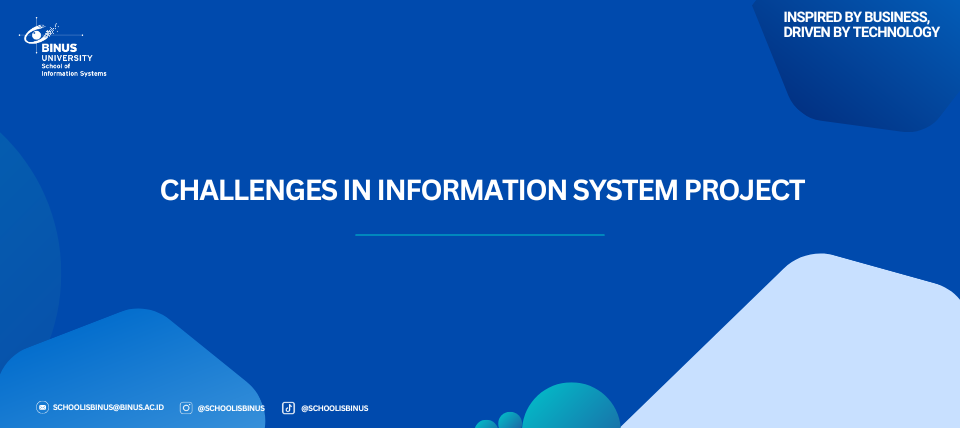Challenges in Information System Project

Information Systems (IS) are organized arrangements of people, processes, data, and technology that work together to collect, process, store, and distribute information. In modern organizations, Information Systems play a crucial role in supporting business operations, enhancing decision-making processes, and providing strategic advantages. As businesses become increasingly dependent on digital solutions, the demand for efficient and reliable Information Systems projects continues to rise. However, despite advancements in technology and project management methodologies, many IS projects still face significant challenges that can affect their success.
One of the most common challenges in Information Systems projects is the difficulty in clearly defining system requirements. Often, organizations embark on system development projects with only a vague idea of what they expect from the system. This lack of clarity can lead to misunderstandings between stakeholders and the development team, causing the final product to fall short of business needs. Furthermore, requirements may evolve over time as organizations adapt to changing market conditions or discover new operational needs during the development process. Without a structured approach to capturing and managing these changes, projects can experience delays, increased costs, and a product that does not fully meet user expectations.
Another significant issue is the lack of user involvement throughout the project lifecycle. End-users are the people who will interact with the system on a daily basis, and their insights are invaluable in ensuring that the system is practical, user-friendly, and aligned with actual workflows. Unfortunately, in many cases, users are either excluded from the decision-making process or consulted too late in the project. This can result in systems that are technically sound but difficult for employees to adopt, leading to poor system utilization and reduced return on investment.
Moreover, Information Systems projects often suffer from scope creep, a situation where new features or requirements are continuously added without proper evaluation of their impact on the project’s schedule and resources. Scope creep can occur when stakeholders request additional functionalities during development or when project objectives are not clearly defined from the outset. While adapting to changing needs is sometimes necessary, uncontrolled scope changes can strain resources, extend timelines, and increase costs, making it difficult to deliver a successful project.
Technical complexity is another challenge frequently encountered in IS projects, particularly in large organizations with existing legacy systems. Integrating new technologies with older platforms, managing data compatibility, and ensuring system interoperability can present significant technical hurdles. Without careful planning and the involvement of skilled technical experts, these complexities can result in unforeseen technical issues, project delays, or the need for expensive adjustments during or after implementation.
Time and budget constraints also pose substantial risks to Information Systems projects. In many cases, initial estimates for project duration and costs are overly optimistic, failing to account for the complexities and unforeseen challenges that arise during system development. As a result, projects may run over budget and behind schedule, affecting overall business operations and stakeholder satisfaction. To address this, organizations must establish realistic estimates, implement effective project monitoring systems, and include contingency plans to manage potential disruptions.
One often underestimated challenge in IS projects is data migration. Transferring data from old systems to new ones is a critical phase that, if mishandled, can result in data loss, corruption, or inconsistencies that affect business operations. The complexity increases when dealing with large volumes of data or when migrating from outdated systems with limited export options. Successful data migration requires careful planning, thorough testing, and robust backup procedures to ensure data integrity throughout the transition.
Lastly, resistance to change is a human factor that can impede the success of Information Systems projects. Employees may fear that new systems will increase their workload, reduce their job security, or require them to learn unfamiliar processes. Without effective change management strategies, this resistance can manifest in low system adoption rates, decreased productivity, and negative attitudes towards future technology initiatives. Addressing this challenge requires clear communication about the benefits of the new system, involving users early in the process, providing adequate training, and offering ongoing support after implementation.
In conclusion, while Information Systems projects offer immense benefits for organizational efficiency and competitiveness, they also come with a range of challenges that must be carefully managed. From unclear requirements and scope creep to technical complexities and human resistance, each obstacle presents a risk to project success. By anticipating these challenges and implementing proactive strategies such as comprehensive requirement gathering, inclusive stakeholder engagement, disciplined project management, and strong change management organizations can improve the likelihood of delivering IS projects on time, within budget, and aligned with business goals.

